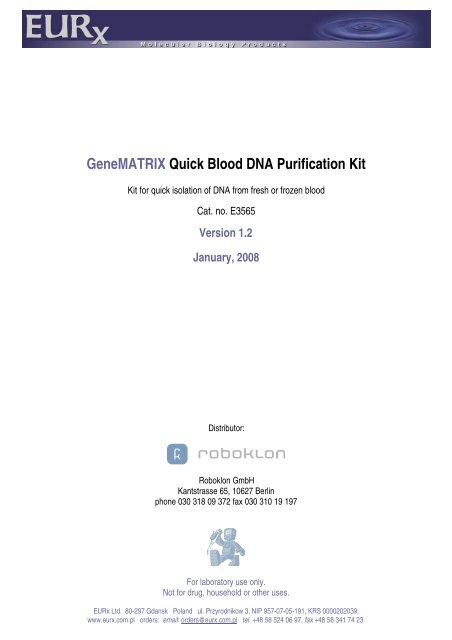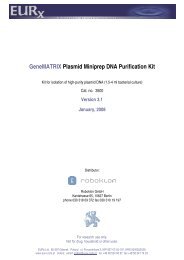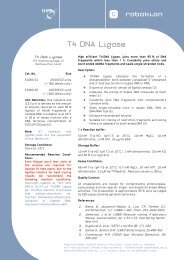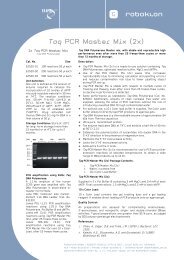GeneMATRIX Quick Blood DNA Purification Kit - roboklon
GeneMATRIX Quick Blood DNA Purification Kit - roboklon
GeneMATRIX Quick Blood DNA Purification Kit - roboklon
You also want an ePaper? Increase the reach of your titles
YUMPU automatically turns print PDFs into web optimized ePapers that Google loves.
<strong>GeneMATRIX</strong> <strong>Quick</strong> <strong>Blood</strong> <strong>DNA</strong> <strong>Purification</strong> <strong>Kit</strong><br />
<strong>Kit</strong> for quick isolation of <strong>DNA</strong> from fresh or frozen blood<br />
Cat. no. E3565<br />
Version 1.2<br />
January, 2008<br />
Distributor:<br />
Roboklon GmbH<br />
Kantstrasse 65, 10627 Berlin<br />
phone 030 318 09 372 fax 030 310 19 197<br />
For laboratory use only.<br />
Not for drug, household or other uses.<br />
EURx Ltd. 80-297 Gdansk Poland ul. Przyrodnikow 3, NIP 957-07-05-191, KRS 0000202039,<br />
www.eurx.com.pl orders: email: orders@eurx.com.pl tel. +48 58 524 06 97, fax +48 58 341 74 23
Note 1: The kit is designed for the rapid isolation of highly pure genomic <strong>DNA</strong> from whole blood, serum, plasma or<br />
other body fluids.<br />
Note 2: <strong>Blood</strong> can be stored in the presence of anticoagulants at 4 o C (up to several days) or frozen (prefered<br />
temperature –70 o C).<br />
Note 3: Once the kit is unpacked, store components at room temperature, with the exception of RNase A and<br />
Proteinase K. RNase A should be kept at 4 o C and Proteinase K at -20 o C.<br />
Note 4: All solutions should be kept tightly closed to avoid evaporation and resulting components concentration<br />
changes.<br />
Note 5: The kit does not contain 96 % ethanol and PBS. To prepare sterile PBS, dissolve: 8 g NaCl, 0.2 g KCl,<br />
1.44 g Na2HPO4 and 0.24 g KH2PO4 in 800 ml H2O. Adjust pH to 7.4 with HCl. Add H2O to 1 liter.<br />
Protocol<br />
1. Apply 40 µl of activation Buffer QB onto the spin-column (do not spin) and keep it at room<br />
temperature till transfering lysate to the spin-column.<br />
Note 1: Addition of Buffer QB onto the center of the resin enables complete wetting of membranes and maximal<br />
binding of <strong>DNA</strong>.<br />
Note 2: The membrane activation should be done before starting isolation procedure.<br />
2. Add 200 µl blood/body fluid to 1.5-2 ml Eppendorf tube.<br />
Note 1: For sample volumes less than 200 µl, add PBS to adjust the volume to 200 µl.<br />
Note 2: If RNA-free <strong>DNA</strong> is crucial for downstream applications, add 2 µl RNase A. Mix by vortexing and incubate<br />
5 min at room temperature.<br />
Note 3: If purifying <strong>DNA</strong> viruses, it is recommended to start with 200 µl serum or plasma to prepare pure viral <strong>DNA</strong><br />
(cellular <strong>DNA</strong>-free).<br />
3. Add 10 µl Proteinase K and next 200 µl SOL-QB buffer.<br />
4. Vortex the mixture thoroughly.<br />
5. Incubate for 10 min at 70 o C.<br />
6. Add 200 µl 96 % ethanol.<br />
7. Vortex the mixture thoroughly.<br />
8. Centrifuge for 1 min at 12000 rpm.<br />
9. Transfer the lysate to the spin-column, placed in the collection tube.<br />
10.Centrifuge for 2 min at 12000 rpm.<br />
Note 1: Continue centrifugation, if not all of the lysate passed through the column.<br />
11.Take out the spin-column, discard flow-through and place back the spin-column in the<br />
collection tube.<br />
2
12.Add 500 µl Wash-QBX1 buffer to the spin-column and centrifuge for 1 min at 12000 rpm.<br />
13.Take out the spin-column, discard flow-through and place back the spin-column in the<br />
collection tube.<br />
14.Add 500 µl Wash-QBX2 buffer to the spin-column and centrifuge for 2 min at 12000 rpm.<br />
15.Place the spin-column in a new collection tube (1.5-2 ml) and add 50-200 µl of Elution buffer<br />
(10 mM Tris-HCl, pH 8.5) heated to 70 o C to elute bound <strong>DNA</strong>.<br />
Note 1: Addition of the elution buffer directly onto the center of the resin improves <strong>DNA</strong> yield. To avoid transfering<br />
traces of <strong>DNA</strong> between the spin-columns do not touch the spin-column walls with the micropippete.<br />
Note 2: The following elution solutions can be used:<br />
1. 5-10 mM Tris-HCl buffer, pH 8.0-9.0<br />
2. 0.5-1 x TE buffer, pH 8.0-9.0 (not recommended for <strong>DNA</strong> sequencing).<br />
3. Other special application buffers can be used, if their pH and salt concentration is similar to that of<br />
5-10 mM Tris-HCl, pH 8.0-9.0.<br />
16.Incubate the spin-column/collection tube assembly for 3 min at room temperature.<br />
17.Centrifuge the spin-column for 1 min at 12000 rpm.<br />
Optional:<br />
18.Repeat elution once again as described in steps 15-17.<br />
Note 1: This step improves <strong>DNA</strong> recovery from the column. A new collection tube can be used to prevent dilution of<br />
the first eluate or collection tube from step 15 can be reused to combine the eluates.<br />
Note 2: More than 200 µl should not be used to elute into a single 1.5 ml microcentrifuge tube, as the spin-column<br />
will come into contact with the eluate, causing <strong>DNA</strong> contamination.<br />
19.Discard the spin-column, cap the collection tube. <strong>DNA</strong> is ready for analysis/manipulation. It can<br />
be stored either at 4 o C or at -20 o C.<br />
3
<strong>GeneMATRIX</strong> is synthetic, new generation <strong>DNA</strong>- and RNA-binding membrane, selectively binding nucleic<br />
acids to composite silica structures. Novel binding and washing buffers are developed to take full advantage of<br />
<strong>GeneMATRIX</strong> capacity, yielding biologically active, high-quality nucleic acids. Matrix is conveniently pre-packed in<br />
ready-to-use spin-format. Unique chemical composition of the matrixes along with optimized construction of spincolumns<br />
improve the quality of final <strong>DNA</strong> or RNA preparation. To speed up and simplify isolation procedure, the key<br />
buffers are colour coded, which allows monitoring of complete solution mixing and makes purification procedure more<br />
reproducible.<br />
As a result, we offer kits, containing matrixes and buffers that guarantee rapid, convenient, safe and efficient<br />
isolation of ultrapure nucleic acids. Such <strong>DNA</strong> or RNA can be directly used in subsequent molecular biology<br />
applications, such as: restriction digestion, dephosphorylation, kinasing, ligation, protein-<strong>DNA</strong> interaction studies,<br />
sequencing, blotting, in vitro translation, c<strong>DNA</strong> synthesis, hybrydization among others. Additional advantage is<br />
reproducibility of matrix performance, as component preparation is carried at Eurx Ltd.<br />
<strong>GeneMATRIX</strong> <strong>Quick</strong> <strong>Blood</strong> <strong>DNA</strong> <strong>Purification</strong> <strong>Kit</strong> is designed for the rapid isolation of highly pure genomic<br />
<strong>DNA</strong> from fresh or frozen blood, serum, plasma or other body fluids. It is also possible to purify viral <strong>DNA</strong> from blood<br />
samples. Purified <strong>DNA</strong> is free of contaminants, such as: RNA, proteins, lipids, dyes, detergents, organic inhibitors of<br />
enzymatic reactions, buffers, salts, divalent cations, among others.<br />
<strong>Blood</strong>/body fluid sample is lysed in the presence of special buffer containing large amounts of chaotropic ions<br />
and Proteinase K. Proteinase K digests cellular proteins, including stripping-off <strong>DNA</strong> of all bound proteins, among<br />
them nucleases. Appropriate conditions for binding of <strong>DNA</strong> to the <strong>GeneMATRIX</strong> resin is created by addition of<br />
ethanol to the lysate. During brief centrifugation step <strong>DNA</strong> binds to the silica membrane in the spin-column, while<br />
contaminants pass through. Traces of contaminants remaining on the resin are efficiently removed in two wash steps.<br />
High-quality cellular <strong>DNA</strong> is then eluted in low salt buffer, e.g.: Tris-HCl, TE or water. Isolated <strong>DNA</strong> is ready for<br />
downstream applications without the need for ethanol precipitation.<br />
EURx Distributor:<br />
Roboklon GmbH<br />
Kantstrasse 65, 10627 Berlin<br />
phone 030 318 09 372 fax 030 310 19 197<br />
EURx Ltd. 80-297 Gdansk Poland ul. Przyrodnikow 3, NIP 957-07-05-191, KRS 0000202039,<br />
www.eurx.com.pl orders: email: orders@eurx.com.pl tel. +48 58 524 06 97, fax +48 58 341 74 23





